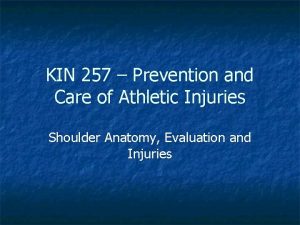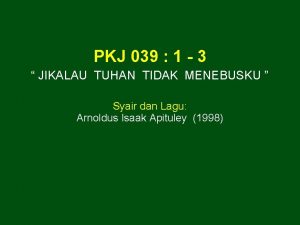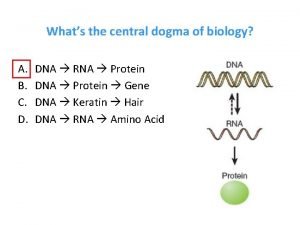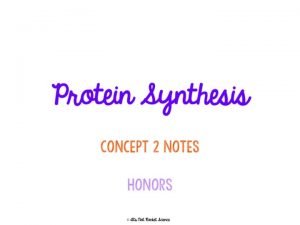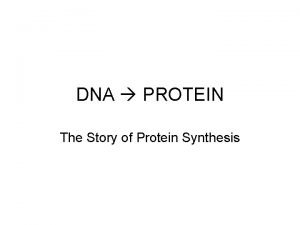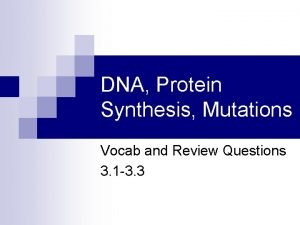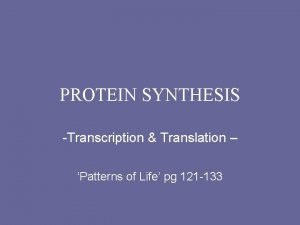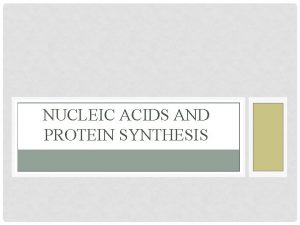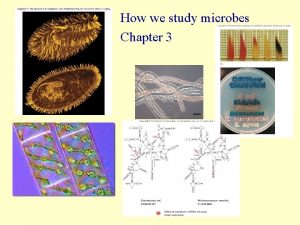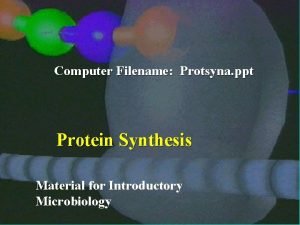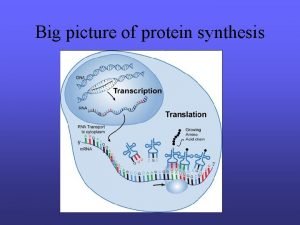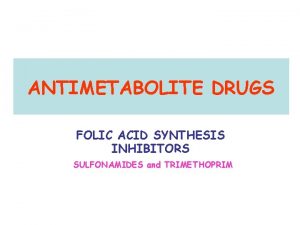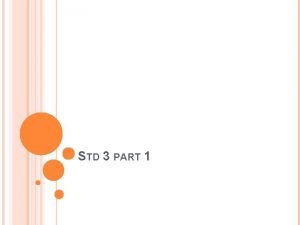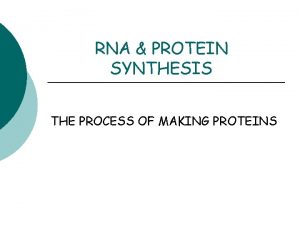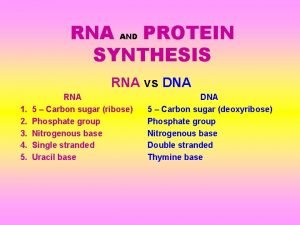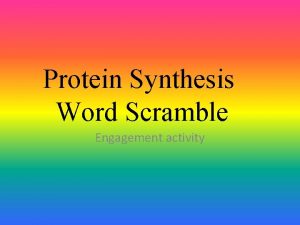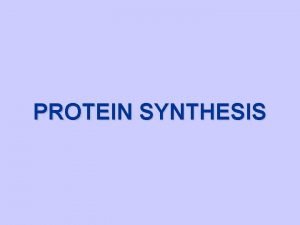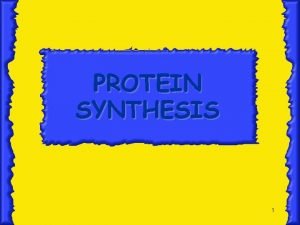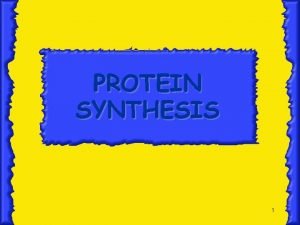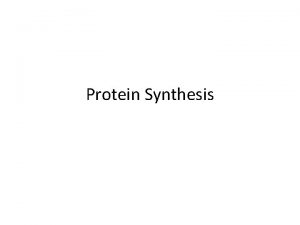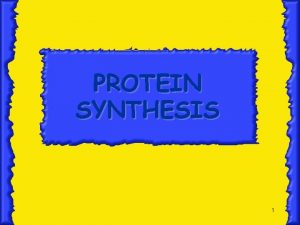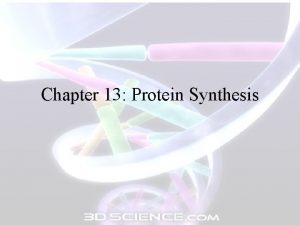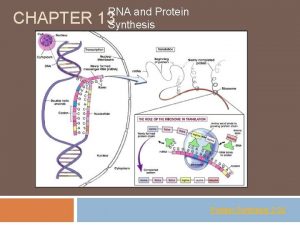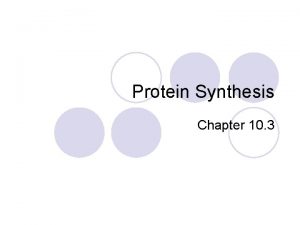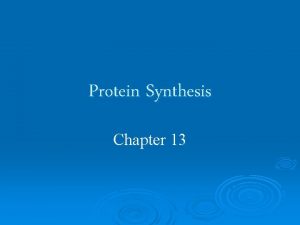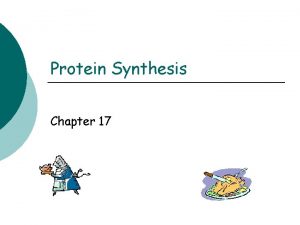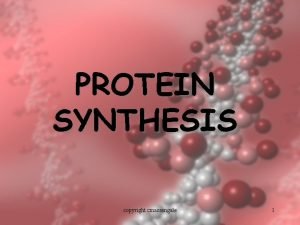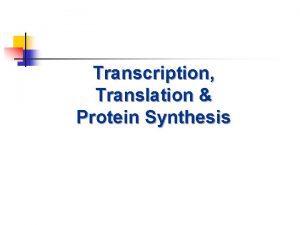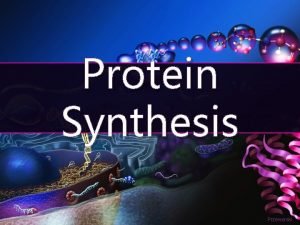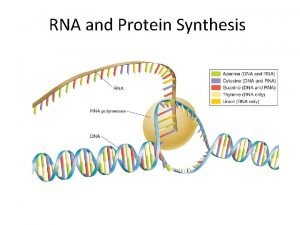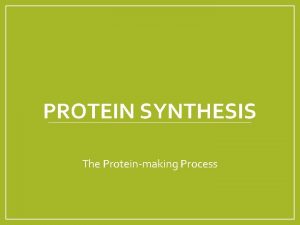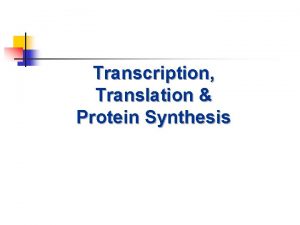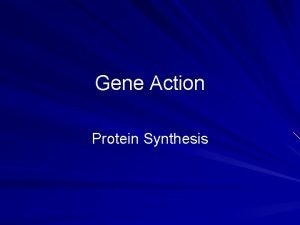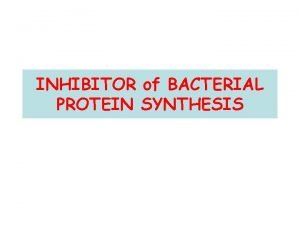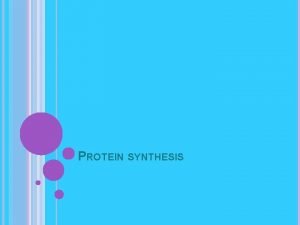Protein Synthesis Chapter 9 p 233 257 Protein































- Slides: 31

Protein Synthesis Chapter 9 p. 233 -257

Protein Synthesis l Gene- segment of DNA that codes for a protein. l Gene Expression/ Protein Synthesis is the process of using DNA’s genetic code to make proteins. n Transcription- RNA is written from the code of DNA in the nucleus. n Translation- Amino Acids are ordered in the proper sequence to form a polypeptide chains in the cytoplasm of the cell. Nucleic Acid is converted to an amino acid sequence. �




RNA l RNA- Ribonucleic Acid Sugar is Ribose n Single stranded n Adenine, Uracil, Guanine, Cytosine are bases n m. RNA- messenger RNA- temporary copy of a gene that encodes a protein. l t. RNA- transfer RNA- cloverleaf shaped molecule that carries amino acids during translation. l r. RNA- ribosomal RNA- with other proteins make up a ribosome, formed in the nucleolus. l sn. RNA- small nuclear RNA- interact with specific protein during RNA processing in eukaryotes. l

t. RNA structure

Genetic Code l Sequence of bases of DNA or RNA that code for Amino Acids. l Codon- three base sequence of m. RNA that codes for an amino acid. l Anticodon- three base sequence of t. RNA that is complimentary to a m. RNA codon. Directs the sequence of Amino Acids. l Types of Proteins made during Protein Synthesis n Structural n Antibodies n Hormones n Enzymes

Transcription l In the nucleus, DNA’s code is transcribed into a molecule of RNA by transcription. l Different types of the enzyme RNA Polymerase will transcibe m. RNA, t. RNA, and r. RNA. l r. RNA and ribosomal proteins are synthesis in the nucleolus. l A complimentary strand of RNA is made from one strand of DNA. l RNA are modified in the nucleus then exit through pores in the nuclear membrane.

Transcription l Only one strand of the DNA- the coding or the template strand, will code for RNA. l RNA made during transcription will be complimentary to the coding strand from DNA. l Initiation n RNA Polymerase will attach to a section of DNA at the promoter site located just before the segment of DNA to be transcribed. n Initiation factor proteins must be present for RNA polymerase to attach to the promoter region.

Transcription l Elongation n RNA Polymerase partially unwinds DNA, exposing coding strand of the gene. n RNA polymerase moves along the strand away from the promoter site as it adds complimentary RNA nucleotides to make a primary transcript. l Termination n When RNA polymerase reaches terminator region, RNA polymerase and RNA primary transcript are released.


RNA Processing l m. RNA can last a few minutes to a few days depending on the way it is processed. l Primary RNA transcript can contain 200, 000 nucleotides, post transcription modifications can reduce mature m. RNA to 1, 000 nucleotides. l All RNA is processed before it leaves the nucleus.

m. RNA Processing l m. RNA post transcription modifications n Enzymes add a methyl guanine nucleotide to the starting tail of the m. RNA. (m. G cap) n Enzymes replace part of the opposite tail with 100200 Adenine nucleotides. (poly-A tail) n The m. G cap and poly-A tail protect m. RNA from enzymes that would break down nucleic acids. (The longer the poly-A tail- the longer the lifespan of the m. RNA) n Poly-A tail helps transport the RNA out of the nucleus.

m. RNA Processing l Segments of m. RNA that do not code for proteins are removed. l Intron- internal segment of m. RNA that does not code for protein. l Exon- Segments of m. RNA that code for proteins remain after splicing. l Splicing- removal of introns and rejoining of cut exons. l Splicing enzymes recognize GU at one end of an intron and AG at the other end.

t. RNA and r. RNA processing l t. RNA processing n Nucleotides are modified and t. RNA molecule is folded into a stable cloverleaf shape with an anticodon and amino acid binding site. l r. RNA processing n Primary r. RNA transcript is spliced and modified into mature r. RNA molecules that will bind to proteins to form the 2 subunits of a ribosome.

Translation l The codon of m. RNA is translated into the amino acid sequence of a protein. l Step 1 - Processed m. RNA leaves the nucleus and enters the cytoplasm and joins with 2 ribosome subunits. The m. RNA start codon (AUG) signals a t. RNA molecule carrying methionine and attaches at the anticodon at the P site. l Step 2 - The next codon at the A site receives a t. RNA with the complimentary anticodon which is carrying a specific amino acid.

Translation l Step 3 - Enzymes in the ribosome form a peptide bond between amino acids. l Step 4 - The ribosome shifts down one codon, the t. RNA at the P-site enters the E site and detaches leaving the methionine behind. l Step 5 - The t. RNA at the A-site shifts to the Psite, the A-site is unoccupied. l Step 6 - A new t. RNA occupies the empty A site. The amino acids are bonded.

Translation l Step 7 - The processes continues until the stop codon reaches the A-site. There is no t. RNA with the anticodon for these codons. A releasing factor protein pairs with the stop codon and causes the new polypeptide chain to be released into the cell.






Protein Modifications l After translation proteins need to be modified to gain a functional structure. l Proteins will fold to obtain tertiary structure. l Sugars can be added to polypeptideglycoprotein. l Proteins can be transported by E. R. n Amino acid signal sequence binds to an E. R. receptor during translation allowing proteins in. n After the signal sequence is removed and sugars are added, the protein is transported to the plasma membrane or Golgi apparatus via vesicles.

Translation Errors l Starting point of a reading frame can be off by one or two bases during Translation. l Mutations- changes in DNA n Point mutation- substitution of one base can cause the change in one amino acid (missense), a premature stop codon (nonsense), or no change at all (silent). n Frameshift mutation- an insertion or deletion of bases in the DNA sequence that will change every subsequent codon. (splicing error, loss of base)

Viruses l Tiny, non-cellular particles that depend on host cells for respiration, gene expression, and reproduction. l Viruses are constructed of n Protein or lipid membrane coating n Small amount of DNA or RNA n Some enzymes

Virus Reproduction l Lytic reproduction- host cell enzymes and ribosomes replicate transcribe, and translate the viral DNA or RNA to make new viruses which cause the cell to lyse. l Lysogenic reproduction- viral DNA (or copy of viral RNA) is inserted into the host cell’s DNA and is replicated when the cell divides. n Viral particles wrapped in the host cell’s plasma membrane may be given off. n Stress on the host cell can activate a lytic cycle.

Viruses l Bacteriophage- type of virus that attacks bacteria. l Retrovirus- virus with RNA, uses process of reverse transcription to turn the viral RNA into DNA that can join the host cell’s DNA n RNA is turned into DNA by enzyme reverse transcriptase. l Antibiotics don’t cure viruses. l Weakened viruses are used for vaccines. l Disarmed viruses can be used to deliver DNA for gene therapy and genetic engineering


 Info 257
Info 257 Kin 257
Kin 257 Kj 257 not angka
Kj 257 not angka Cs 257
Cs 257 Totipotent cell
Totipotent cell Section 12-3 rna and protein synthesis answer key
Section 12-3 rna and protein synthesis answer key Protein synthesis
Protein synthesis Cell analogy restaurant
Cell analogy restaurant Transcription and translation
Transcription and translation Protein synthesis bbc bitesize
Protein synthesis bbc bitesize 4 steps of protein synthesis
4 steps of protein synthesis Protein synthesis cookie analogy
Protein synthesis cookie analogy Protein synthesis
Protein synthesis Protein synthesis
Protein synthesis Protein synthesis
Protein synthesis Protein synthesis
Protein synthesis Protein synthesis and mutations
Protein synthesis and mutations Rna and protein synthesis study guide
Rna and protein synthesis study guide Synthesis
Synthesis Protein synthesis and mutations
Protein synthesis and mutations Protein synthesis animation mcgraw hill
Protein synthesis animation mcgraw hill Pap protein synthesis worksheet
Pap protein synthesis worksheet Translate
Translate Ribonucleic acid
Ribonucleic acid Ribosome
Ribosome Protein synthesis ppt
Protein synthesis ppt Picture of protein synthesis
Picture of protein synthesis Protein synthesis inhibitor
Protein synthesis inhibitor Which best summarizes the process of protein synthesis?
Which best summarizes the process of protein synthesis? Concept map of protein synthesis
Concept map of protein synthesis Protein synthesis
Protein synthesis Protein synthesis scramble
Protein synthesis scramble

